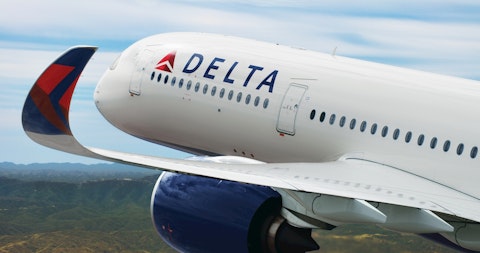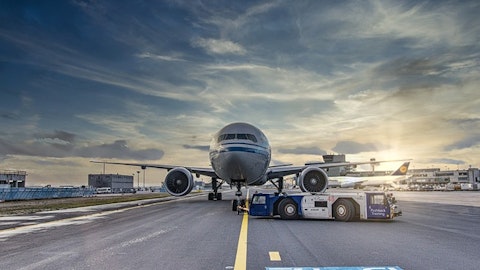Delta Air Lines, Inc. (NYSE:DAL) Q3 2023 Earnings Call Transcript October 12, 2023
Delta Air Lines, Inc. beats earnings expectations. Reported EPS is $2.03, expectations were $1.92.
Operator: Good morning, everyone, and welcome to the Delta Air Lines September Quarter 2023 Financial Results Conference Call. My name is Matthew, and I’ll be your coordinator. At this time, all participants are on a listen-only mode until we conduct a question-and-answer session following the presentation. As a reminder, today’s call is being recorded. [Operator Instructions] I would now like to turn the conference over to Julie Stewart, Vice President of Investor Relations. Please go ahead.
Julie Stewart: Thank you, Matthew. Good morning, everyone, and thanks for joining us. Today, in Atlanta, we are joined by CEO, Ed Bastian; our President, Glen Hauenstein; and our CFO, Dan Janki. Ed will open the call with an overview of Delta’s performance and strategy, Glen will provide an update on the revenue environment, and Dan will discuss costs and our balance sheet. After the prepared remarks, we’ll take analyst questions, and then we’ll move to our media questions. Today’s discussion contains forward-looking statements that represent our beliefs or expectations about future events. All forward-looking statements involve risks and uncertainties that could cause the actual results to differ materially from the forward-looking statements.

Pixabay/Public Domain
Some of the factors that may cause such differences are described in Delta’s SEC filings. We’ll also discuss non-GAAP financial measures, and all results exclude special items unless otherwise noted. You can find a reconciliation of our non-GAAP measures on the Investor Relations page at ir.delta.com. And with that, I’ll turn the call over to Ed.
Ed Bastian: Well, thank you, Julie, and good morning, everyone. We appreciate you joining us. Before we start, I want to acknowledge the unfolding war in Israel and the tragic loss of life that has ensued. Delta is donating $1 million to the American Red Cross for the International Committee of the Red Cross to help fund humanitarian efforts in the conflict. This includes emergency assistance such as health services, emergency care, ambulance services, and other critical needs. Our inbound and outbound flights to Tel Aviv have been suspended through October 31st to ensure the safety and security of our customers and employees. We’re also offering a customer waiver for travel to Tel Aviv for those who need to change their travel plans.
Our hearts with everyone impacted by these tragic and horrific events. Turning to our news for the day. This morning, Delta reported September quarter results, posting earnings of $2.03 per share, a 35% increase over last year. Revenue grew 13%, and we achieved a 13.5% operating margin. This resulted in operating income of $2 billion, bringing our operating profit over the last 12 months to over $6 billion. The Delta people delivered for our customers throughout the very busy summer season. And I’m grateful to our teams for all they do for our customers and each other every day. Our people are the foundation of Delta and are our most important competitive strength. Sharing our financial success with our people is a long-standing pillar of Delta’s culture.
With this quarter’s financial performance, we accrued another $420 million towards next February’s profit sharing. This brings our profit sharing accrual to over $1 billion year-to-date, marking an important and exciting milestone for the Delta team. The great work of our 100,000 people was recently recognized as Delta ranked number 12 overall on Time Magazine’s list of The World’s Best Companies. We were the only airline to make the top 100 of this prestigious list. And USA Today readers just selected Delta as the Best Airline in the World. Our operational fundamentals remain strong, underscored by Delta’s industry-leading position in on-time arrivals and blue sky operational performance that is reliably back to pre-COVID levels. Following a high number of irregular operations days early in the quarter, driven by weather and ATC constraints, we have seen consistent improvement in our operating metrics.
In October, we are running a near-perfect completion factor across the mainline system, and we remain number one in on-time arrivals year-to-date. As we’re now in the final phase of our recovery, we are making important forward-leaning investments in the health and reliability of our fleet. These maintenance investments will position us to consistently deliver the operational excellence that underpins Delta’s brand. Running a high-quality operation is critical to being the airline of choice for our customers and driving a competitive cost structure. Dan will speak more to this shortly. During the quarter, we also made a $150 million strategic investment in Wheels Up, co-investing alongside Certares Management, Knighthead Capital and others.
This new investment structure combines the number one premium commercial airline with the travel and tourism expertise of Certares and the turnaround expertise of Knighthead. Delta’s relationship with Wheels Up creates a new premium product line for our customers, and I look forward to working with our co-investors and the new management team to unlock the full value of this uniquely positioned business. Turning to our outlook. Travel remains a top purchase priority and our core customer base is in a healthy financial position. We continue to see strength in bookings across Delta’s global network, driven by our consumers. Demand for premium experiences, international travel, and increasing business travel further differentiate the trends that Delta is seeing within the industry.
We expect our December quarter revenues to be 10% higher than 2022, with a 10% operating margin and earnings of over $1 per share. This brings our expectation for full year earnings to over $6 per share on a double-digit operating margin and free cash flow of $2 billion. Since raising full year guidance over the summer, our revenue outlook has improved, though earnings and cash flow have been impacted by higher fuel and maintenance costs. Revenue for the full year is expected to increase 20% over last year, which was the high-end of our expectations on steady domestic demand and continued strength in international. With strong top line growth and margin expansion, we expect to double earnings year-over-year and deliver a 13% return on invested capital.
Our outlook for 2023 keeps revenue, earnings, cash flow and debt reduction on track with our three-year plan, which we issued in December of ’21. As we progress through the recovery, we have made meaningful investments in operational reliability and our people. Delta has led the industry in setting the bar for wages, including a new pilot deal and profit sharing. We are seeing the structural step-up in operating costs amid increasing fuel prices, creating some near-term pressure on industry margins. However, I fully expect that the market will adjust to higher costs as it has historically and reestablish equilibrium. With Delta’s differentiated premium revenue strategy and strong global network, we will continue to deliver industry-leading profitability and generate robust free cash flow.
In closing, the strategy that we shared at Investor Day positions us well for the future. And while the operate — the environment we operate in continues to evolve in this post-COVID world, our objectives are unchanged as we move into 2024. With our network rebuilt and growth now moderating, optimizing the airline and driving efficiency are significant opportunities. Thank you, again, for your support of our company. And with that, let me hand it over to Glen and to Dan to go through the details of the quarter.
Glen Hauenstein: Thank you, Ed, and good morning. I want to start by thanking all of our employees for their hard work and dedication during the busy summer travel season. In the September quarter, Delta generated revenue of $14.6 billion, up 13% over prior year. Total unit revenues were down 2.5%, including 1 point of pressure from cargo and MRO. With these results, I expect Delta to deliver a record September quarter unit revenue premium versus the industry, reflecting the continued success of our commercial strategy. Domestic passenger revenue was up 6% over prior year. Performance was steady through the quarter with strength in our coastal hubs, where we are leveraging our leading positions in generational airport bills.
International passenger revenue grew 35%, with the Transatlantic and Pacific outperforming our already high expectations. We delivered record margins across all international entities this summer and strength is continuing through the fall. Demand for our premium products is very strong with revenue up 17% over prior year, outperforming main cabin by 5 points. Domestic paid load factor in our first-class cabins was a record as we continue to advance our premium merchandising and upsell capabilities. Delta Premium Select has now been rolled out to over 85% of long-haul flights, and the revenue generation from this product has been above expectations and a key contributor to our record international margins. Business travel continues to steadily improve as corporates continue with return-to-office initiatives.
Less recovered sectors like technology and financial services saw double-digit growth during the quarter. Our recent corporate survey indicates continued growth in business demand with a significant majority of companies expecting their travel to stay the same or increase as we move into 4Q and into ’24. SME and hybrid travelers are producing margins in line with corporate travelers and demand from these travel remains well above 2019 levels. Total loyalty revenue was up 17% over prior year, with continued strength in our American Express co-brand portfolio. Amex remuneration of $1.7 billion grew approximately 20% over prior year. We expect full year remuneration of close to $7 billion and are focused on reaching our long-term goal of $10 billion.
Diversified revenue streams, including premium and loyalty, have generated 55% of revenue year-to-date, reflecting Delta’s differentiated positioning to the industry. Turning to the December quarter, we expect total unit revenue to grow 9% to 12% over prior year, bringing our full-year revenues to up 20% over prior year. This is at the high end of our guidance even with a few points less capacity than we had planned for the year, reflecting robust demand for the Delta product. Capacity in the fourth quarter is expected to be up 14% to 15%, implying total unit revenues down 2.5% to 4.5% versus prior year. Domestic and Transatlantic trends are expected to be consistent with the third quarter. Pacific and Latin America unit revenue trends are expected to be modest — excuse me, expected to modestly decelerate given capacity growth related to China reopening and investment in our LATAM JV.
Domestic demand remains steady and initial bookings for the peak holiday periods are strong. The ongoing UAW and actor strikes are having a modest impact and we have incorporated those into our outlook. As we move through the fourth quarter, our Domestic capacity growth moderates and, in the first quarter of 2024, we expect domestic capacity to be flat to slightly down year-over-year. We have reallocated capacity to international leisure where we are expecting strong returns and remain focused on fully restoring our higher-margin core hubs. On international, we are seeing continued demand strength through the winter. The Transatlantic remains very strong, driven by partner hubs and southern European leisure traffic performance. We’re closely monitoring the situation in Israel as we will evaluate restarting the flights as the situation stabilizes.
In the Pacific, we expect to grow December quarter capacity 40% to 50% as we continue restoring the network. While this level of growth will impact unit revenue, we expect the new flying will be profit accretive. For the year, we remain confident in finishing strong with record profitability across all three international entities. In closing, I’m proud of the revenue performance our teams have delivered, and I’m confident that our integrated commercial strategy will continue to drive industry-leading profitability. And with that, I’ll turn it over to Dan to talk about the financials.
Dan Janki: Thank you, Glen, and good morning to everyone. For the September quarter, we delivered earnings of $2.03 per share and operating margin of 13.5%. Non-fuel unit costs were up 1.3% year-over-year, and fuel prices averaged $2.78 a gallon, including a refinery benefit of $0.11. We generated operating cash flow of $1.1 billion, and we invested — reinvested $1.4 billion into the business. Liquidity ended the quarter at $7.8 billion and adjusted net debt of $20.2 billion. Year-to-date, we’ve repaid $3.7 billion of gross debt. This is including $1.7 billion of accelerated repayment on our higher cost debt. Our leverage ratio improved to 3 times on a trailing 12-month basis. During the quarter, S&P upgraded our credit rating to BB+, one notch away from investment grade, a recognition of our improving financial foundation.
Our capital allocation priorities are reinvesting in the business and improving our balance sheet to investment-grade metrics, with a modest cash return to shareholders through our dividend. Now moving to guidance. For the December quarter, we expect non-fuel unit costs to be flat to up 2% on a year-over-year basis. With the exception of maintenance costs, our second-half unit costs are progressing as expected. As we discussed in September, there are three drivers to higher maintenance: first, investment in fleet health; second, expanded work scope on our 757 engine fleet; and third, challenges across the supply chain. On fleet health and reliability, our investments are starting to deliver improved operational performance. Our September metrics were ahead of August, and October is ahead of September.
On the 757 engine, a workhorse in our fleet, we’re going through a wave of overhauls. The engines we took off wing over the summer required larger work scope and a higher mix of new parts. Looking forward, we are forecasting higher new material consumption rates. On supply chain, the industry continues to face challenges that will take time to work through. Engine and airframe turnaround times remain elevated, driving inefficiency and impacting productivity. We are working closely with our partners and leveraging our deep expertise in TechOps to manage supply chain challenges. Delta has a long heritage of industry-leading operational performance driven by the best TechOps capability in the industry. Operational excellence is central to our brand promise and a key pacing item to drive out inefficiencies.
Moving to fuel. Fuel prices have moved higher since July, adding roughly $400 million of expense to our outlook for the second half of the year. We expect December fuel prices to be $2.90 to $3.20 per gallon, with the refinery expected to be roughly breakeven for the quarter. The refinery turnaround is progressing as we planned, and we expect production to resume in mid-November. Based on our December quarter outlook for revenue and cost, we expect earnings of $1.05 to $1.30 per share on a 9% to 11% operating margin. This brings our full-year outlook to earnings to $6.00 to $6.25 per share on double-digit operating margin and free cash flow of $2 billion. We are focused on finishing the year strong, remain committed to delivering industry-leading margin performance, earnings growth and strong cash generation.
As we progress through the 2024 planning process, our focus is shifting from restoration to optimization. Over the last two years, we’ve grown at an unprecedented rate for an airline of our size to restore our network. Growth is normalizing next year, and we expect operational reliability to continue to improve. This will allow us to optimize how we run the airline, reducing operational buffers, and driving out inefficiencies that have resulted from the intensity of the rebuild. Our capacity growth for 2024 will be focused on Delta’s areas of strength. Domestically, we are prioritizing our core high-margin hubs, driving connectivity and gauge. Internationally, we are leveraging our best-in-class JV partnerships and increasing the mix of flying on next-generation aircraft.
We are executing against the strategy and financial objectives we laid out at our Investor Day with an emphasis on free cash flow, earnings durability, and capital efficiency. In closing, Delta is well positioned to maintain industry leadership operationally and financially. I’d like to sincerely thank the Delta people for everything they do every day. With that, I’ll turn it back to Julie for Q&A.
Julie Stewart: Thanks, Dan. Matthew, can you please remind the analysts how to queue up for a question?
See also Top 15 Bioplastics Companies in the World and 15 Most Common Reasons You’re Likely to Get Fired.
Q&A Session
Follow Delta Air Lines Inc. (NYSE:DAL)
Follow Delta Air Lines Inc. (NYSE:DAL)
Operator: Certainly. At this time, we’ll be conducting a question-and-answer session. [Operator Instructions] Your first question is coming from Jamie Baker from JPMorgan. Your line is live.
Jamie Baker: Hey, good morning, everybody. So, Dan, expanding on some of your engine comments, we’re obviously focused on the GTF situation. I realize you’re not or at least I don’t believe you’re directly impacted with any groundings right now. I’m just trying to square the situation against your MRO and your GTF in-house expertise. I mean, is there a scenario where the Pratt mess ends up benefiting Delta? Or should we think more about simply reducing the downside relative to some of your peers? Also how does this impact the maintenance cost guide embedded in your 2024 CASM expectations? Thanks.
Dan Janki: Maybe I’ll first start with the geared turbofan as it relates more directly to our fleet both. On the neo, we took our deliveries later, so the impact will be modest to minimal. If there are any inspections or things off-wing, it will be in the latter half of 2024 based on the analysis that we’ve gotten so far from Pratt. We’re still waiting on the full analysis related to the 220 fleet, that should be coming later this month, and we will assess that impact appropriately. As it relates to MRO, Pratt is certainly a close partner of ours and an important one as it relates to that third-party capability and we will certainly support their efforts. We’re working closely with them on that. We have capacity. It ultimately comes down to the allocation of capacity and availability of material to do the work, but we’ll be working with them through the fall and into next year on that.
Jamie Baker: Okay, that’s helpful. And then for Glen, I’ve asked about this before, a lot of Delta customers obviously took fairly lavish European vacations this year. You have SkyMiles data on these folks. What’s the correlation between big summer spenders and big winter spenders? What’s that, I don’t know, sort of SkyMiles Venn diagram look like? Because what I’m wondering about is the potential for people scaling back on their winter trips because they’ve spent lavishly on their summer holidays. Any actual data you can share on that? Thanks again, guys.
Glen Hauenstein: Sure. I think what we’re really excited about is the lengthening of the European travel season. And that has really gone from primarily ending in the summer IATA season, which would be October, now through November, through the holidays, through the New Year. And really now we’re only talking about a six to eight-week period that are the doldrums for Europe. So, the bookings, which most people wouldn’t have expected, of course, we reduced our schedule in the fall and the winter IATA season. But our year-over-year comps are actually accelerating into the winter as we look into November, December and January. So, I think we’re seeing that continuing into the fall and early parts of winter, and we’re very excited about that.
And we’ve also, of course, expanded into a lot more Latin leisure this winter than we did last winter, and the advanced demand for that seems very, very robust. So, leisure is still very strong, and even through shoulder and off-peak periods.
Jamie Baker: Okay. Thanks, Glen. Thanks, everybody. Take care.
Operator: Thank you. Your next question is coming from Savi Syth from Raymond James. Your line is live.
Savi Syth: Hey, good morning. If I may, Glen, just your comment about domestic capacity being flat to down in the first quarter. I was just wondering if that was a decent trend for the full year or is it — was related to also, in the last year, the way first quarter kind of turned out wasn’t what you expected and you were going to make some capacity changes. So, is that related to that as well, or is it more kind of weakness that you’re seeing recently, or maybe strength in international on a relative basis?
Glen Hauenstein: It’s really a reshaping of the demand patterns that we saw last year. And no shock, January and February are not in the northern tier, transcon, east-west markets, barnburner markets, so reallocating those to warmer and sunnier places. So, our total capacity will be up. Domestic capacity will be down slightly. Core hubs will actually be up with more emphasis on warm and sunny places in Latin America and South Pacific. So that’s kind of how we’re profiling and really optimization of the demand patterns we saw last year going into this winter.
Savi Syth: That makes sense. And if I may also just on domestic revenue. It’s been stable at Delta since kind of June. I was wondering how much of a contribution you’re getting from restoring your hubs and separately perhaps the domestic portion of international trips, given what you’ve talked about the strength kind of continuing in Transatlantic longer than kind of historic. The reason I ask it, it seems that stable comment is a little bit different than maybe what we’re hearing from kind of the purely domestic airlines.
Glen Hauenstein: Right. I think what domestic strength is really coming from are the premium products domestically. And I’m not going to speak for the other carriers. They all have coming in the next few weeks. But it really hasn’t been on domestic portion of international journey, which is de minimis in terms of the variance to what it was last year. Our employments in the Transatlantic are up low double digits, but that only represents 13% of our total travel, so really a de minimis impact to domestic. So, it’s really coming from the premium products, and they’re doing quite well. As I mentioned, domestic paid first-class load factors are reaching new heights every month. So, very excited about those demand trends and I think that reinforces the strategy we’ve been working on for the last 10 years to have a differentiated product.
Savi Syth: Helpful. Thank you.
Operator: Thank you. Your next question is coming from Conor Cunningham from Melius Research. Your line is live.
Conor Cunningham: Hey, everyone, thank you. Ed, in the prepared remarks, I think you touched on fuel recapture. Right now, there doesn’t seem to be much of an adjustment on the capacity side from some of your indices participants, despite like erratic fuel. So, just trying to understand if there’s a new calculus to how you’re approaching fuel recapture right now in the current market. Thank you.
Ed Bastian: Well, obviously, fuel moved an awful lot within just the last couple of months. And it’s the volatility of fuel that really hits us hard as compared to the ability to recapture it. I think traditionally, we’ve seen over a two to three-quarter rise. We have a pretty good success rate at recapturing it. When you think about the strength of the demand environment and the fact that across the board, everyone has — not just fuel costs are up, but labor rates are increasing and other inflationary pressure, supply chain and maintenance costs are up. Everyone has a similar incentive to continue to be able to recalibrate those pricing — those market pressures into pricing. So, my outlook is I’m optimistic as we’re going into ’24. Glen can add his own color there.
Glen Hauenstein: No, I think you mentioned it really well. It takes time, and when we have rapid fuel price run-ups, it usually takes a few quarters for that to roll into the industry realized fares. But historically, it’s always worked. So, we’re looking at history to predict the future, but that’s what the history would tell you.





